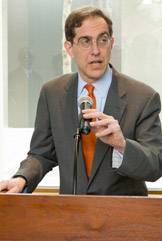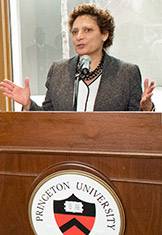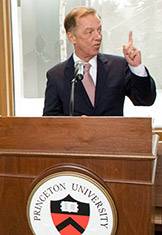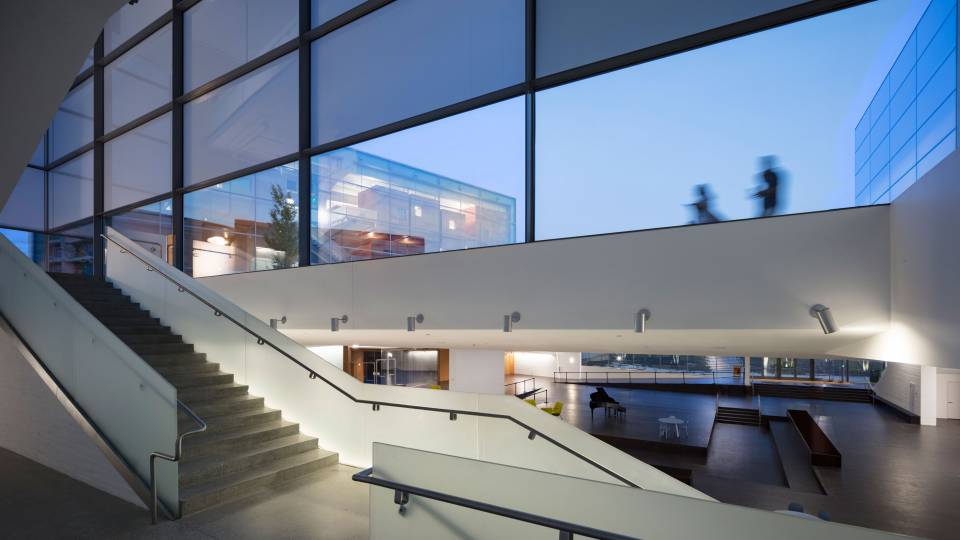With a ceremonial ribbon-cutting, speeches and the whoosh of the Dinky train's departure, officials celebrated the opening of the new Princeton Station on Tuesday, Nov. 25.
Representatives from Princeton University, the town of Princeton, the state and the project's design and construction firms were on hand for the celebration, commenting on the importance of the station and transit services to the University and town.
"I'm very pleased that we have reached this milestone in our Arts and Transit Project, the building of this gorgeous new Princeton station," Princeton President Christopher L. Eisgruber said.
The train service, he said, "is important to the University as well as to the town. For members of our campus community, the station is an important link to the Princeton Junction Station and from there the rest of the country and on to the world. I hope you will join us in looking forward to the completion of a project that will animate this neighborhood with a glorious combination of artistic and communal spaces."
The station is part of the University's Arts and Transit Project, which involves redeveloping the Alexander Street-University Place intersection by shifting transit services south, opening a restaurant and café and constructing new arts buildings near McCarter Theatre Center by fall 2017. The station, which began operation on Nov. 17, provides service between Princeton and Princeton Junction on a two-car NJ TRANSIT train known as the Dinky. The new Wawa and a transit plaza also are open.
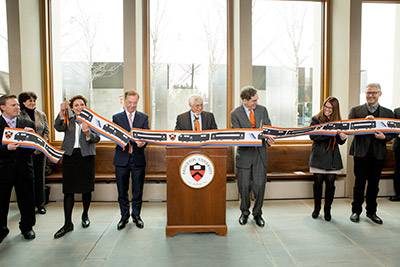
Representatives from Princeton University, the Town of Princeton, the state and the station's design and construction firms cut a ribbon featuring an illustration of the two-car Dinky train.
Jamie Fox, commissioner of the New Jersey Department of Transportation and chair of the NJ TRANSIT board, said: "This is a beautiful facility. It's a great addition to the University and to the state of New Jersey."
Ronnie Hakim, executive director of NJ TRANSIT, commended the smooth partnership between the town, University and state to serve the 850 NJ TRANSIT customers who use the station each day. "It is a true partnership when … a University [and] a town comes together with a public partner, and this is the outcome," she said. "We are celebrating this beautiful station, the beautiful convenience store, the sustainability of the design and the thoughtful construction that led to getting this building open."
Princeton Mayor Liz Lempert commented on the Dinky's long history, from references in literature and film to its value to past riders such as Albert Einstein and present-day commuters. Said Lempert: "We love our Dinky, we're passionate about our Dinky, and we believe in the importance of public transit and the vital connection it provides for all Princetonians. We stand here today eager to work in partnership with the University, with NJ TRANSIT and the state to ensure that this new chapter for the Dinky is going to be its most successful one yet."
University Vice President and Secretary Robert Durkee, who emceed the event, praised the station's design, saying it "produced a civic space that is truly inspiring and beautiful and comfortable and functional, and that announces clearly and compellingly to passengers and passersby that Princeton not only has a train station but is proud of its train station and its train." He added that one of the most exciting aspects of the project is that it serves "as a crossroads where town and gown intersect and share common space."
Durkee sounded a train whistle, signaling to Eisgruber, Fox, Hakim and Lempert to cut the ribbon with gold-handled scissors festooned with small ribbons in Princeton's colors, orange and black. Before and after the ceremony, more than 100 people attending the ceremony mingled in and around the station and enjoyed refreshments served in a tent on the plaza. All the while, students rolled their luggage onto the train platform as they prepared to board for travels on Thanksgiving recess.
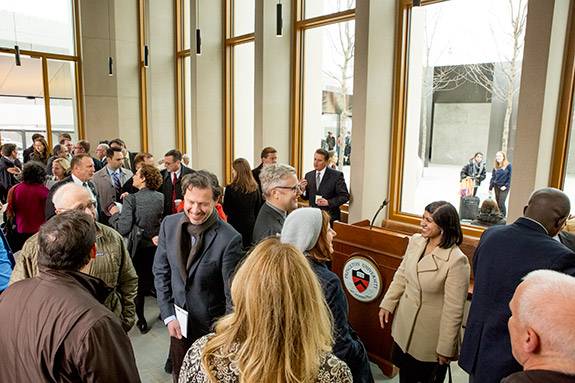
Students (right) waiting for the Dinky look through the Princeton Station windows as attendees chat after the celebration.
New buildings anchor transit plaza
Princeton Station and the Wawa were designed by Rick Joy Architects, based in Tucson, Arizona, and several common elements tie the structures together. A courtyard with honey locust trees and a canopy along the platform connect the buildings.
The station's pitched roof, rising to 42 feet, addresses earlier public concerns that the building would be hard to find. "It's tilted up as if waving to people along Blair Walk, coming from Nassau Street," said Matt Luck, an architect with Rick Joy Architects.
The station's exterior is made of precast concrete pillars and glass, and the ceiling is made of blackened steel panels. The Wawa's columns and three exterior walls also are made of blackened steel panels.
Among the station's most distinct elements are the Nakashima Woodworker benches, created by the New Hope, Pennsylvania, studio of the late master craftsman George Nakashima, renowned as a furniture designer and maker in the mid-20th century. The studio, run by his daughter and apprentice, Mira, is known for simple, elegant pieces that combine quality craftsmanship and materials, highlighting the unique characteristics of the wood. Luck said the black walnut benches — each unique, with wood Nakashima selected — bring local artistry and warmth to the station, and a contrast to the concrete, steel and bluestone inside.
"We always wanted there to be a warm, inviting element to the station, something on a human scale and something tactile and approachable," Luck said.
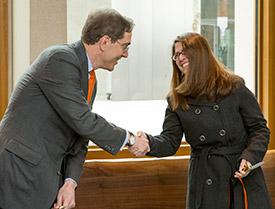
Eisgruber shakes the hand of Princeton Mayor Liz Lempert following the ceremony.
Variety of transit options
The new transit plaza accommodates a number of transit options and services.
- Pedestrian: A variety of pedestrian paths and sidewalks link the station to the town and campus.
- Bicycles: The station features bike racks and a new bike rental program. Additionally, bike storage lockers have been added to the West Garage.
- Cars: The station has permit and metered parking, as well as a taxi stand. A "kiss-and-ride" area allows motorists to drop off or pick up commuters. The University also has created a new access road between the campus and Alexander Street, called North Station Drive, which provides easy access to the West Garage. The garage is restricted to permit holders weekdays from 5 a.m. to 5 p.m. and is open to the public on evenings and weekends.
- Buses: A bus stop in front of the station serves NJ TRANSIT buses, the University's TigerTransit shuttle and the Town of Princeton's FreeB shuttle.
- Trains: The Dinky provides service to and from Princeton Junction, where riders can connect to trains traveling along the East Coast.
- Wawa: The new convenience store, which opened Nov. 21, is open 24 hours a day and offers public restrooms for commuters.
